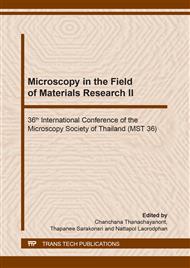p.51
p.63
p.71
p.79
p.85
p.93
p.101
p.107
p.115
Microstructure and Mechanical Performance of Fiber-Reinforced Cement Composites Made with Nucleating-Agent Activated Coal-Fired Power Plant Bottom Ash
Abstract:
The purpose of this work was to study the microstructure and the mechanical properties of the fiber-reinforced cement composites that used the nucleating-agent activated coal-fired power plant bottom ash as a raw material in the mixture for producing the composites. The raw materials for producing the fiber reinforced cement composites were the ordinary Portland cement (OPC), natural gypsum, cellulose fiber, and bottom ash. The bottom ash was chemically treated by the nucleating agent, a chemical that was prepared by the precipitation process from the aqueous solutions of sodium silicate (Na2SiO3) and calcium nitrate (Ca (NO3)2). To prepare the samples, the mixture consisting of 34.75 wt% OPC, 34.75 wt% bottom ash, 25 wt% natural gypsum, and 5.5 wt% cellulose fiber was mixed with the nucleating agent at the amount of 0 to 4.5 % of OPC weight in the mixture, and water to form the slurry. Then, the samples were produced by filter pressing process and cured in the autoclave for 16 hrs at 180 °C, and 10 bars. The mechanical properties of the samples including modulus of rupture (MOR), modulus of elasticity (MOE), and toughness were characterized by the universal testing machine (UTM). The microstructures of the samples were observed by scanning electron microscope (SEM). The results showed that the utilization of nucleating agent affect the microstructure of the sample leading to the improvement in the mechanical properties of samples.
Info:
Periodical:
Pages:
85-92
Citation:
Online since:
April 2020
Price:
Сopyright:
© 2020 Trans Tech Publications Ltd. All Rights Reserved
Share:
Citation:


